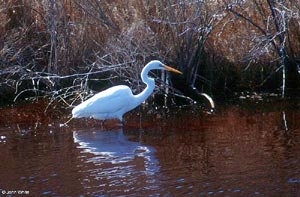 From the 1940s to the 1960s, E.A. Vaughn WMA was a game farm where a number of pheasant species were raised and released. It was also an area where wildlife biologists experimented with plants and planting arrangements which would most benefit wildlife. Today, these plantings and the mixture of forests, fields and marshes attract and support a multitude of wildlife species.
From the 1940s to the 1960s, E.A. Vaughn WMA was a game farm where a number of pheasant species were raised and released. It was also an area where wildlife biologists experimented with plants and planting arrangements which would most benefit wildlife. Today, these plantings and the mixture of forests, fields and marshes attract and support a multitude of wildlife species.
What To See
Woodcock, hairy and downy woodpeckers, and warblers inhabit the extensive forest. In the marshes, great blue, green and little blue herons, as well as common and snowy egrets, hunt for fish. Black ducks, mallards, Canada and snow geese, and other waterfowl use the marshes and open water found in and around the area. Wood ducks are especially attracted to an area of forest deliberately flooded in the fall when the trees are dormant. This area is called a "greentree reservoir" and is also home to frogs and toads, turtles and snakes. Endangered Delmarva fox squirrels were released on the area and have been thriving there for a decade. Because of their preference for open woodlands and wood edges, these squirrels are often observed from cars driving along the woods. Migrating hawks can be seen in the fall as they travel down the East Coast.
What To Do
For hunters, white-tailed deer, gray squirrels, mourning doves, woodcock, bobwhite quail, ducks, geese and cottontail rabbits are plentiful. E.A. Vaughn has an area designated for physically challenged hunters. Trapping is offered by yearly lease. Visitors will enjoy hiking or all-terrain bicycling on one of the many unmarked trails. A primitive camping area is available for overnight stays. Anglers can bottom fish for sea trout, croaker, spot, flounder or bluefish. Crabbing is also possible.
Area Regulations
- Use of the E. A. Vaughn WMA is generally permitted seven days a week throughout the year.
- Hunting is allowed in accordance with open seasons and shooting hours, unless otherwise noted.
- All State and Federal Hunting Laws and Regulations are applicable.
- Trapping is by permit only.
- Delmarva fox squirrels are present, no hunting of this Federally endangered species is permitted.
- Dove hunting is restricted to certain days and shooting hours.
- No motorized vehicles are allowed.
Site Management Goals
- The agricultural fields are planted with crops to provide habitat and winter food for upland wildlife species.
- Several impoundments have been created and are managed to provide habitat for waterfowl, wading birds, and aquatic mammals.
- Certain fields are managed dove hunting areas.
- Riparian areas have been planted with trees and grasses to create riparian buffers for water quality and wildlife habitat benefits.
- Some fields have been planted to native warm season grasses, cool season grasses and/or been left fallow to provide habitat for ground nesting wildlife species.
Special Areas
- Disabled hunter access is permitted in designated area.
- A primitive camping area is located off of Rt. 12 south of Girdletree (contact the office below for more information).
Non-hunting Users Guide
- Non-hunting visitors are welcome.
- Be aware of open hunting seasons and visit accordingly.
- Season dates available in newspapers, on the Internet, and at some area stores.
- Trails are maintained and suitable for hiking, nature photography, birding, hunting and other recreational activities, but are not actively marked.
- Visitors to the management area should be aware that there may be biting flies, mosquitoes, and ticks present during April - November.
- Anglers can bottom fish for sea trout, croaker, spot, flounder or bluefish. Crabbing is also possible.
 Directions
Directions
E. A. Vaughn WMA is located in southeastern Worcester County on MD Route 12. From U.S. 50, take MD 12 south to Girdletree and to E. A. Vaughn WMA. Vehicle access: via marked parking areas located off Taylor Landing, Snow Hill, and George Island Landing Roads. Boat access: via Taylor Landing and George Island Landing public boat ramps. For additional information, contact the Wellington Wildlife Office at (410) 651-2065.
Maps
Photograph of Great Egret Courtesy of John White
This area is a part of Maryland’s Department of Natural Resources public land system and is managed by the Wildlife and Heritage Service. The primary mission of the WMA system is to conserve and enhance wildlife populations and their respective habitats as well as to provide public recreational use of the State’s wildlife resources.
Eighty-five percent of the funding for Maryland's state wildlife programs comes from hunting license fees and a federal excise tax on sport hunting devices and ammunition. The federal aid funds are derived from the Federal Aid in Wildlife Restoration (or Pittman-Robertson) Fund, which sportsmen and women have been contributing to since 1937. Each state receives a share of the funds, which is administered by the U. S. Fish and Wildlife Service; these funds are used for wildlife conservation and hunter education programs, including the management of the WMA system.
Other sources of funds for land acquisition include Program Open Space Funding for Maryland's State and local parks and conservation areas, provided through The Department of Natural Resources' Program Open Space. Established in 1969, Program Open Space symbolizes Maryland's long-term commitment to conserving natural resources while providing exceptional outdoor recreation opportunities.